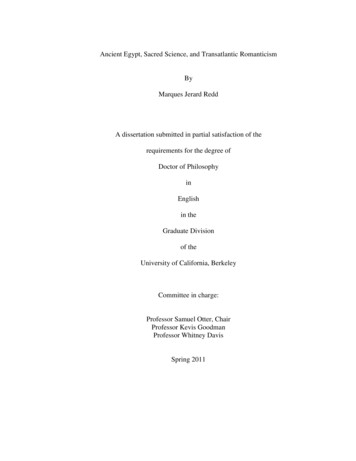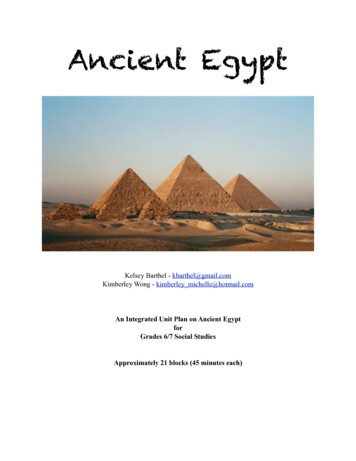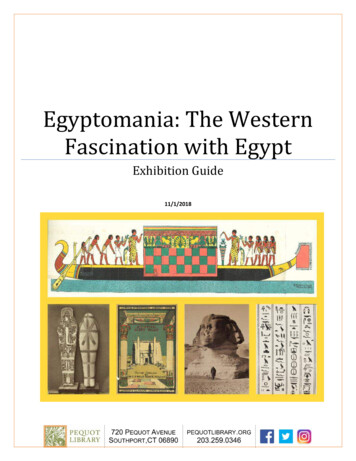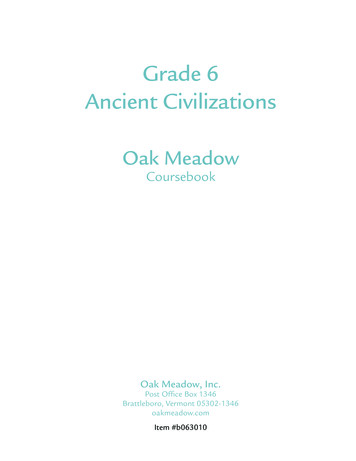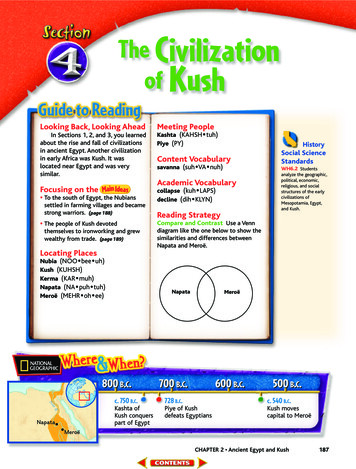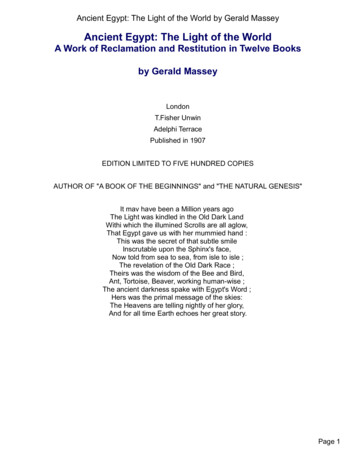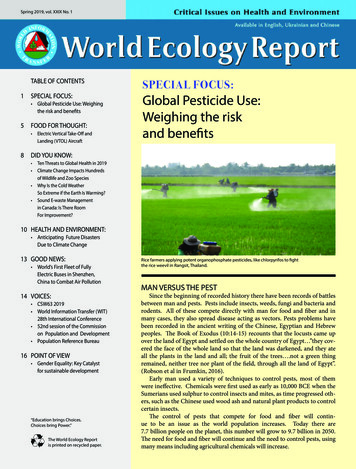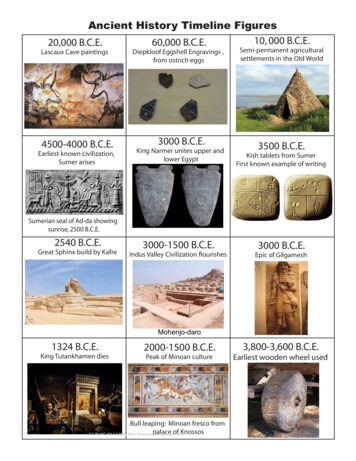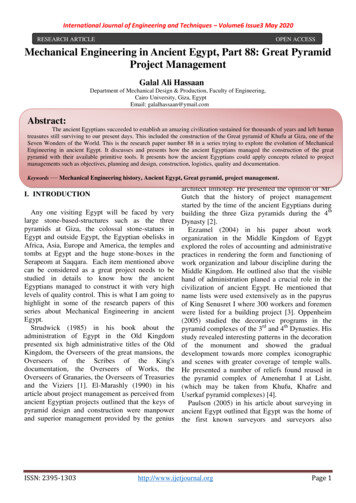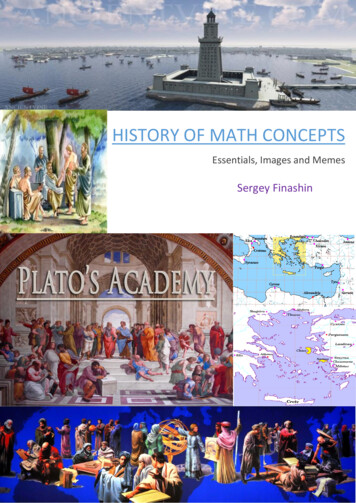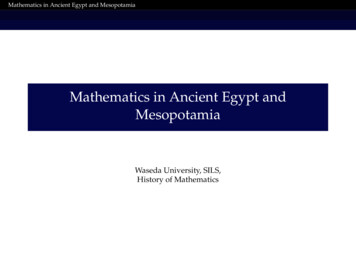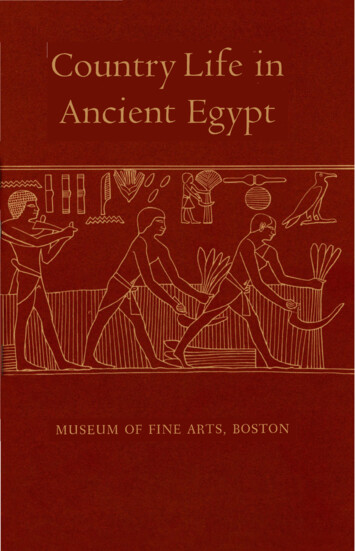
Transcription
Country Life inAncient EgyptM U S E U M OF FINE ARTS, BOSTON
COUNTRY LIFE INANCIENT EGYPTM U S E U M OF F I N E ARTS, BOSTON
MUSEUM OF F I N E ARTSPicture BookNO. 2PREPAREDBY DR. WILLIAMSTEVENSONSMITH,CURATOROF EGYPTIANART IN THE MUSEUMCover Design: Harvesting grain in the Fifth Dynasty tomb chapel of Sekhem-ka(G 1029) at Giza; from an unpublished drawing of Norman de Garis DaviesPRODUCED BY T H E M E R I D E N GRAVURE CO.MERIDEN, CONNECTICUT
Country Life in AncientEgyptEgypt has rightly been called the gift of the Nile. I n a countryof little rain, the regular annual inundation of the river has produced a rich soil that made agriculture the source of the nation’sprosperity. Although great cities grew up in the narrow desertbordered valley, the Egyptian nevertheless felt himself close to thesoil. The country is like no other land. Nearly always within viewis the sharp contrast between the green fields and the tawny deserthills that hem in the cultivation on each side. Between summer andlate autumn a sheet of water from the river-flood lay across thefields. Out of this rose the villages as though they were islands.The peasant used one word interchangeably for either field ormarsh, since only for a part of the year would this be dry land. Inthinking of the world after death he imagined a similar ‘Field ofReeds’ and ‘Field of Offerings’ where islands rose from a heavenlyinundation for the repose of the transfigured dead.I n a mild climate, the resurgence of plant life after the regularlyrecurring Nile floods encouraged belief in a stable universe and therenewal of life after death. All living things were maintained bythe powers of the Sun God Ra from the bright sky above, whileother manifestations of nature were personified in the gods whichbrought order to the universe. Characteristics admired or feared inthe animal world were thought to be divine manifestations, - theswift power of the bright-feathered falcon moving through theheavens, the deadly poison of the cobra, the fierceness of the lionor the strength of the bull. This partly accounts for the fascinatingportrayal of animals and plant life in Egyptian art. Perhaps morethan anything else, the charmingly expressed belief in the beneficence of the sun fostered that love of nature which is the delightof Egyptian sculpture and painting.In very early times the Nile Valley did not present the promiseof an easy existence for the Prehistoric Egyptian. He was faced withimpenetrable papyrus thickets and formidable animals such as thecrocodile, hippopotamus and elephant. The swampy jungle had tobe cleared by the first settlers and the river-floods mastered bydikes and canals. Even after this irrigation system became estab-
lished, the outlying swampy areas remained a fixed part of Egyptianlife. Through the marshes were ferried the cattle to their grazinggrounds and, here, the sportsmen caught birds in clap-nets andwith the throwing stick, fished and hunted the hippopotamus. Therocky desert hills supplied other game for the hunter.The control of the river by dikes and canals freed large tractsof land for the cultivation of grain and flax and the growing of fruittrees and vegetables in the gardens of the country houses and smallvillages. The great estates were self-contained, maintaining in addition to the agricultural laborers, the workshops of various crafts tosupply the needs of the establishment.An amazing record of this life in the country has survived, dueto the fact that the Egyptian believed that he would continue in theAfterworld in much the same manner as he had done on earth.Thus his daily life was pictured on the walls of his tomb or modelsof characteristic activities were buried with him along with his personal possessions that they might become magically efficacious. Thesame instinct led to the creation of life-like stone statues of theowner of the tomb, his family and his servants.Our very representative collection of these fine products of theancient craftsmen, therefore, evokes a revealing picture of a vitaland creative people. We are fortunate in that the greater part ofthe collection comes from the excavations of the Museum's Expedition, maintained for over forty years, and can thus be closely related to the historical background. The following group of pictureshas been selected to convey something of the charm and intimatehuman side of Egyptian country life as well as the artistic achievement of a great civilization.
1. ALABASTER THRONE OF KING MYCERINUS: Dyn.IV. 09.202This heraldic design, combining the symbols for the United Kingdom, contrastswith the Map of the Afterworld in our last picture where the king will rule inhis divine form as Horus. Nile Gods tie together the plants of Upper and LowerEgypt beneath the serpent goddess Buto who represents the North. The king’snames, protected by the Horus falcons under the sky emblem, identify this statuewhich stood in his funerary temple at the Third Pyramid of Giza about 2600 B.C.
2. FRAGMENT OF LIMESTONE THRONE OF KING AY:Dyn. XVIII. 50.3789The Nile God tying the papyrus of Lower Egypt about the emblem for the joining of the two lands maintains the same symbols 1250 years after Mycerinus.The style, though, is now one of flowing curved lines and a softer treatment ofthe forms, characteristics that lingered on at Thebes after the collapse of Akhenaten’sten’s brief religious revolution.
3. RELIEF FROM KA-EM-NOFRET’S CHAPEL: Dyn. V. 04.1761The papyrus thickets provided good places for hunting and fishing as well as theraw materials for paper, ropes and matting. In this Saqqarah tomb, about 2 5 0 0B.c., men carry home from the swamps their catch of fish and birds. Others cutbundles of papyrus and make mats and rope.
4. PAINTED MEROITIC JAR FROM KERMA. 13.4035Feared in Egypt from Predynastic Times, the crocodile was to be found morefrequently in the region of the cataracts, and to the south where Kerma lay, bythe time this pot was made in the Second or Third Century A.D. One monster’sbody curves around the upper part of the jar while another is engaged in swallowing an unfortunate native of the Sudan.
5. DETAIL OF IVORY BOX INLAYS (partly in the KhartumMuseum and partly in Boston) : Dyn. XXV.6. ELEPHANTS ENGRAVED ON A BRQNZE MEROITIC VESSEL.The ostrich and elephant were rarely represented in Egypt itself, although foundsouth of its border. The delicately carved bird beside a date palm shows howthoroughly the Kushites had absorbed the Egyptian style by the Eighth CenturyB.C. when this ivory was placed in the tomb of King Shabako at El Kurru in theSudan. The later elephants are drawn in the clumsy but vigorous manner of thepainted Meroitic crocodile opposite, with which they are contemporary.
7. FAIENCE JAR FRAGMENT FROM KERMA: Dyn.XII.20.12358. RELIEF FROM KA-EM-NOFRETS CHAPEL: Dyn. V. 04.1761The Egyptian artist observed the bird life in swamps, field and orchard. Above,he has sketched fluttering birds on a vessel found in the fortified trading post thatwas maintained in the Sudan at Kerma between 1980 and 1700 B.C. Below, onecan recognize herons, ibis, pigeons, cormorants, a kingfisher, hoopoe and lapwing, as well as a butterfly and a grasshopper, in the careful drawings of theOld Kingdom artist, about 2500 B.C.
9. FAIENCE HIPPOPOTAMUS FROM KERMA: Dyn. XII.I 3.412110. PAINTED EARLY PREDYNASTIC BOWL FROM MESAEED.11.312The early Egyptian has caught something of the menace of the formidable hippopotamus in his simple drawings at about 4 0 0 0 B.C. Some two thousand yearslater the Middle Kingdom craftsman has affectionately given a more benign aspectto this small figure.
11. LIMESTONE RELIEF FROM GIZA: Dyn. IV. 34.59Prince Ka-wab, the eldest son of Cheops, the builder of the Great Pyramid, isshown returning from a day’s fowling, about 2630 B.C. With him are cages ofducks which have been caught with the aid of a decoy heron which stands on topof the cages.
12. LIMESTONE RELIEF FRAGMENT OF THE LATE PERIOD.40.619With a calf and vessels containing provisions, these girls are boating in themarshes as in early times. However, at about 400 B.c., the modelling of theirbodies begins to show a contrast with the flat treatment and simple outlines ofthe Old Kingdom relief opposite. This probably resulted from contact with theGreeks and their new sense of depth and volume in natural forms.
13. PAINTED HIEROGLYPHS ON COFFIN LID OF DJEHUTYNEKHT: Dyn. XII (about 1870B.c.).20.182614. DETAIL OF BED CANOPY OF QUEEN HETEP-HERES(copy of Cairo Museum original): Dyn. IV (about 2650 B.C.).38.873
15. SMALL CLOISONNB IBIS: New Kingdom (1570-1085B.c.)04. 174816. QUAIL IN A BOX: limestone royal relief: Dyn. XII.(about 1950 B.c.). 54.647The sensitivity of the craftsman to his medium appears in the painted vulture,opposite, where the brush strokes produce a different impression from the hard,meticulous engraving of the Old Kingdom goldsmith. More formal is the treatment of the enamel and gold ibis, while bold, simple surfaces are used by thesculptors who carved the magnificent decorations of the pyramid temple ofSesostris I, excavated by the Metropolitan Museum at Lisht.
17-19. DETAILS OF THE BERSHEH COFFIN OF DJEHUTYNEKHT: 20.1822 Dyn. XII (about 1 8 7 0 B.c.).20.1826The painter of the Bersheh coffin has portrayed with extreme delicacy a lizard,a serpent, a crested ibis, young quail, an owl and a stork.
20. REPRODUCTION OF A SILVER BRACELET OF QUEENHETEP-HERES and some of the original inlays of carnelian, turquoiseand lapis-lazuli: Dyn. IV (about 2650 B.c.). 47.169921. HIEROGLYPHS ON HETEP-HERES’ BED CANOPY: Dyn. IV.38.873The butterflies are more formal in design than the hornet with its careful observation of the attachment of wings and legs. Skilled craftsmen served the mother ofthe builder of the Great Pyramid at Giza at a period of culmination in the arts.
23.54.64422. 04.176124. 04.1760The viper, owl and rabbit are hieroglyphs from an inscription in the Dyn. Vchapel of Ka-em-nofret from Saqqarah, about 2500 B.C. The giraffe's head comesfrom the pyramid temple of Sesostris I at Lisht, about 1950 B.c., excavated bythe Metropolitan Museum. Ptah-sekhem-ankh's retainers are returning from thehunt with a stag, hyenas and a hare, about 2500 B.c., in his chapel from Saqqarah.
25. LIONS AND HOUNDS ATTACKING A CALF AND ANTELOPEon a Dyn. XVIII wooden toilet box (about 1400B.c.).49.49326. IVORY BED INLAYS FROM KERMA: Dyn. XII (about 1850B.c.):Crestedcrane (20.1323),runninggazelle (20.1377), eagle (13.4204),giraffes (20.1344,1544), pairedgoats (20.1374), ibex (13.4219),h y e n a ( I 3.422I), and ostrich ( 2 0 . I 332).Hunting in the desert rivalled the pursuits in the marshes as a sport. The movement of the animals becomes more agitated in the drawing of the New Kingdom,but note how the Kerma gazelle already raises its legs in a gallop nearly fivehundred years earlier.
27. WOODEN MODEL OF A SAILING BOAT MANNED FOR TRAVELON THE RIVER: Dyn. XII (about 1870 B . c . ) .19.16228. DETAIL OF A SAQQARAH STELA: FIRST INTERMEDIATEPERIOD (about 2200 B.c.).24.594In a period of poverty and political chaos, the artist has abbreviated the earlierscenes to a few essential figures in a small space: a man forcibly feeding a goose,a woman with supplies and a calf, and a man bringing back lotus flowers andpapyrus from the marshes.
29. MAN PLOWING WITH A YOKE OF OXEN: woodenmodelfrom Bersheh: Dyn. XII. 21.40830. MAN FEEDING AN OX: WOODEN MODEL FROM BERSHEH:21.819Dyn. XII (about 1870 B.c.).
3 1. SAQQARAH RELIEF OF PTAH-SEKHEM-ANKH: Dyn. V(about 2 5 0 0 B.c.).04.1760A typical agricultural scene on an Old Kingdom estate shows men plowing withoxen, men cutting grain and driving loaded donkeys to the threshing floor.
32. RELIEF OF PTAH-SEKHEM-ANKH: Dyn. V (about 2 5 0 0 B.c.).04.1760Harvesters forking a pile of grain beside the threshing floor; note the baby donkey.
33. THE PRODUCE OF THE FIELDS AND MARSH. Detail of thepainted Bersheh coffin of Djehuty-nekht: Dyn. XII (about 1870 B.c.).20.1822
34. AN OLD KINGDOM FAMILY OF THE LAND-OWNING CLASS.Detail of a statue of Pen-meru with his wife and children from Giza:12.1484Dyn. V (about 2550 B.c.).
35. LIMESTONE STATUETTE OF AN OLD KINGDOM WOMANGRINDING GRAIN: Dyn. V (about 2500 B.c.).21.260136. SERVANTS ON AN ESTATE MAKING BREAD: woodenmodel04.1782from Assiut: Dyn. XI (about 2 0 5 0 B.c.).
37. POTTERY HOUSE MODEL FROM RIFEH: Dyn. XII (about1870 B.C.).07.550These pottery models were actually used as trays for food offerings at the tombbut represent such a house as might have stood on a country estate. Beyond thepond in the courtyard, the house is entered by doors at the back of the colonnade.Two of the rooms had barrel vaults suggesting that the building was of brickwith wooden columns. The railed space on the roof was probably where thefamily slept on hot nights.38. WOODEN MODEL OF BRICK-MAKERS FROM BERSHEH:Dyn. XII. 24.41IThe worked mud was pressed into molds and laid out to dry in the sun.
39.27.85340. 38.873The hawk form of the God Horus is seen here as a gold amulet, probably ofDyn. XII. The bird is in flight on the gold covered bed canopy of the Dyn. IVQueen Hetep-heres. The king was called the ‘Living Horus’ during his reign andbecame one with the god after his death.
41.39.74643.07.53242. 04.1761Of the nature deities, Horus and the Sun God Ra were intimately related. Thefalcon wings of Horus frame the earliest sun disk on the end of the Dyn. IVcurtain box of Hetep-heres, about 2650 B.C. and appear under the sky emblemon the relief from the Deir el Bahari funerary temple of the Dyn. XI KingMenthu-hotep about 2050 B.C. When Ra is shown in the name of the Dyn. VSun Temple of King Weserkaf, in the Ka-em-nofret chapel about 2 5 0 0 B.c., hisname is determined by a hawk on a standard. Note how the sun rests on top ofthe obelisk-shaped construction which imitates the Ben-ben stone in Ra’s sanctuary at Heliopolis. The association of the two gods is usually expressed: RaHorus-on-his-horizon (Ra-Horakhte).
44. MYCERINUS SLATE TRIAD: Dyn. IV (about2600 B.c.).09.20045. NEW KINGDOM STELA FROM GIZA (about 1300 B.c.).34.50The cow-horned goddess Hathor was the patroness of the royal family in Dyn.IV. Above, she protects Mycerinus, the builder of the Third Giza Pyramid. Beside her is the personification of the Hare Nome, the province in which liesBersheh. Below, Hathor appears from her sycamore tree to present cool waterand refreshment to a worshipping family, thirteen hundred years later than thePyramid Age.
46. DETAILS OF THE PAINTED WOODEN COFFIN OF MEN-KAB:First Intermediate Period (about 2150 B.c.). 0 3 . 1 6 3 1Spelled out in the delightfully clumsy hieroglyphs of a period of decline in the arts are theepithets of Osiris as Lord of Busiris in the Delta and Abydos in Upper Egypt. A god of vegetation who was once a king on earth and resurrected after death, Osiris is shown seated with aroyal crown and flail, and standing in mummy form as ruler of the dead.
47. SIDE OF INNER COFFIN OF DJEHUTY-NEKHT FROM BERSHEH:Dyn. XII (about 1870 B.c.).21.962This rare diagrammatic rendering of the Afterworld forms a pendant to our first picture whichsummed up the Egyptian’s earthly kingdom. It illustrates the Book of the Two Ways, showingan upper route by water and a lower land road leading past obstacles which the dead mustavoid to reach the pleasant Fields of Reeds and of Offerings. It is based on the country theEgyptian knew, with islands rising from the inundation. Here, however, there are lakes offire and places guarded by fearful demons. From this were developed characteristic passagesin the New Kingdom Book of the Dead. Mingled in the representation are beliefs concerningthe regions in the sky of the Sun God Ra and the Kingdom of Osiris in the Underworld.
Ancient Egypt MUSEUM OF FINE ARTS, BOSTON . COUNTRY LIFE IN ANCIENT EGYPT MUSEUM OF FINE ARTS, BOSTON . MUSEUM OF FINE ARTS Picture Book NO. 2 PREPARED BY DR. WILLIAM STEVENSON SMITH, . the workshops of various crafts to supply the needs of the establishment. An ama
